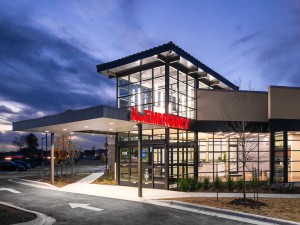By; David Wilson, CCIM, Executive Vice President, Lockard Development
 One of latest trends in health care real estate is the freestanding emergency department (FSED).
One of latest trends in health care real estate is the freestanding emergency department (FSED).
The number of FSEDs has doubled in the last decade, and these facilities are now available in nearly every state.
FSEDs have come under some scrutiny, especially as the Affordable Care Act works to lower the cost of medical treatment. Some have expressed concern that people confuse FSEDs with urgent care facilities and end up paying more for treatment they could have received at the latter.
Despite this concern,FSEDs will play a more critical role in the overall health care system. Rather than replacing certain types of care, FSEDs are actually filling a major void in growing communities. In the last 25 years,demand for emergency care has grown at the same rate that non rural hospital emergency departments have closed, according to The Journal of the American Medical Association.
The American College of Emergency Physicians recognizes two types of FSEDs: a hospital outpatient department (HOPD), also referred to as an off-site hospital-based or satellite emergency department (ED), and independent freestanding emergency centers (IFECs).
Freestanding ERs are not the same as urgent care centers. They operate similar to hospital ERs in that most are open 24/7 and on holidays, accept ambulance transports and offer the same services such as radiology and laboratory services. Many have contractual agreements with local Emergency Medical Services.
What makes FSEDs a viable growth market in health care real estate? One reason is the increasing demand for medical care that will strain the current system.
As the demand for emergency care has exploded, the supply of emergency care within hospitals has actually shrunk. This has created a situation in which patients arriving at an ER can wait hours before receiving treatment. FSEDs have alleviated some of that burden. The Urgent Care Association of America found that freestanding ERs treat a third as many patients as a hospital-based ER. As such, average waiting times were a third less at FSEDs.
It isn’t just a shortage of traditional ERs that will spur growth in FSEDs. The American Academy of Medical Colleges projects that by 2025, demand for physicians will exceed supply by a range of 46,000 to 90,000, including a shortage of between 12,500 and 31,100 primary care physicians (PCPs). Studies show primary care physicians reduce the utilization of emergency departments, so it’s conceivable that a shortage of PCPs will increase ER usage.
FSEDs will also thrive because of the flexibility they offer. They can be strategically located to take advantage of demographics and growing communities. They can help their hospital or physician ownership to extend their brands into outlying areas.
As certain areas get more densely populated, FSEDs serve the purpose of providing more accessible emergency care. That’s why more of these care facilities are popping up in the outer suburban rings of major metropolitan areas.
For example, In the suburbs of Austin, Texas, Lockard has completed one freestanding ER (Round Rock, Texas) and is currently working on two others (Dripping Springs and Pflugerville). All three state-of-the-art facilities are just over 9,000 square feet, yet offer comprehensive emergency care. Five Star ER is open 24/7 and employs emergency trained medical personnel. It contains fully equipped labs and imaging centers offering CT, X-ray and Ultrasound services. Five Star ER is conveniently located for easy patient access and has little to no wait time. Patients are seen, treated immediately, and released in as little as one-fifth the time as traditional hospital ERs.
In growing communities that can’t yet support a full-service hospital, FSEDs and urgent care facilities give those residents a full suite a medical care. FSEDs could possibly be the answer to the decline in available care in rural areas as well.
FSEDs will continue to be an effective option for expanding the availability of emergency health care to areas currently not served and in metropolitan areas where outlying communities have expanded well beyond the traditional placement of hospitals.
